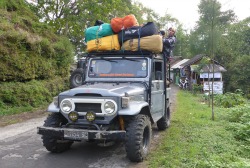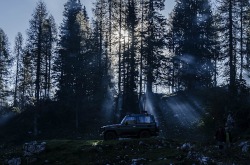
The sh*t just hit the fan. Things have gone from bad to worse and you and your family are in the affected area. Now what?
Whether you are a seasoned prepper or just beginning on the journey down the road to preparedness, there may come a time when you will have to make the decision whether to bug in or hit the road to a safer location with your family. When that time comes, here are the first four things to consider before you start bugging out by vehicle:
- Which vehicle should I take?
- What should I take with me?
- Where am I headed?
- What will be the safest route to take?
1. Which Vehicle Do I Take?

For those of us who don’t own a Hummer, the decision may be a little harder. Things to consider in an escape vehicle are ground clearance, four wheel drive or not, load capacity, fuel consumption and toughness. Even if you plan on bugging in during an emergency, not having a backup plan complete with a remote location that is well supplied could prove fatal.
Case in point and mentioned often is when Hurricane Katrina hit New Orleans. Thousands of people hit the roads to evacuate and many had no idea of where they were headed.
This lack of planning led to panic and indecision that only made matters worse. Horror stories of people stranded on overpasses and people being attacked at rest stops filled the news. Many people waited until it was too late to leave and perished as a result of poor or no planning. So, what vehicle will you take? I would take the vehicle that I feel is the safest for me and my family. In my case, we have a GMC Envoy 4WD.
It is not the toughest vehicle, but it is better than our Kia Spectra. This GMC gives me a fair load capacity and the option of better traction if needed. I always keep at least three quarters of a tank of fuel in my vehicle at all times and make sure my oil, fluids and tire pressure are good.
Having 4WD is a nice option but don’t let 4WD give you a false sense of security. My wife and I learned this a few weeks ago while checking a new clear cut on our leased property in our Jeep Liberty 4WD. I had driven on these roads before but the logging activity had damaged the roads badly. I hit a soft spot, came to a stop and sank. I confidently shifted into 4 wheel low range and tried to drive out but with no luck and sank deeper. I rocked the vehicle back and forth but sank deeper. So deep, that I would not be able to get it out. I am confessing this to try and help you avoid my same mistakes.
Things in my Jeep
1. A ranch jack: Can be used to lift the front or rear onto stable ground.
2. Straps or chains: Can be used with a jack or come along.
3. Folding shovel: Dig around the tires to improve traction
4. Ratchet straps: Can be used to strap a board or tree limb for self rescue.
5. Snow chains: Can be used in snow, ice or mud to improve traction.
6. A hand-operated come along: Able to wench the vehicle out.
7. A tool kit: For small repairs.
8. Leather gloves
9. Extra towels
10. Hatchet or hand axe
These are just a few of the most important things needed in a bug out vehicle to be able to self rescue. Unfortunately, my story didn’t end like a fairy tale. I had to hike out to civilization and find someone with a 4WD tractor to pull me out. My wife, (not in the best of moods by now, had to wait in the submerged jeep for me to make it back with help).
2. What Do I Take With Me?

Decide that now and not when you find yourself having to haul butt. My wife and I found ourselves with about ten minutes to make that decision while living in Durango, Colorado. The Missionary Ridge fire had changed directions within minutes and we had to load our vehicle and leave the rest behind. We didn’t have time to deliberate on what was important. We just grabbed the CPU to our computer, a few clothes, water, dog food, people food, sleeping bags and a tarp for a shelter. As we left our drive way, I remember thinking that it may be the last time I would see our home and the things we had to leave behind.
One thing that I learned from living in Colorado was to always keep emergency supplies in our vehicle at all times. The weather in the Rockies is constantly changing and can be very unpredictable. I have seen it snow in August, rain anytime and hail in midsummer. Temperature swings from hot to freezing in a matter of hours. We are seeing more of these extreme weather patterns throughout the United States so be prepared.
My list includes the following:
1. Two blankets (wool if possible).
2. Drinking water (can be used for water for the vehicle if needed).
3. Food bars
4. Fire starter
5. Emergency shelter
6. Small stove with fuel
7. Flash light with extra batteries
8. Multi tool
9. First Aid Kit
10. Cell Phone and charger
I did have most of these items when we got stuck and my ever present firearm with extra ammunition. Fortunately I was close enough to hike out for help but I might not be able to the next time. I learned a lesson to never leave these items at home or base camp again. Now I keep a loaded box with what I need in my garage. Everything we need is prepped and ready to load at a moment’s notice. My advice to everyone is to take the time to do this now, not at the last minute when you are under intense pressure. You will be glad you did. I know that I have forgotten some things not listed above but you get the idea. If you have to leave, you don’t know what you will be facing or when you may be back.
Related: A Campground As A Bug Out Location?
If you take the time now when not under pressure, you will be less likely to forget the things you will need. So please, think it through and put your plan together now. Don’t put it off and become a victim or a statistic we read or hear about on the news.
3. Where Am I Headed?

My family is fortunate to have some leased land that we can use as a safe place to bug out. It has all of the resources that we would need to survive in an emergency. We store some things there on site to help us from having to carry too much with us. Every evacuation plan should have a well thought out destination. If you don’t have a land lease, maybe you should consider State or National forests. The downside to this would be having to share space and resources with other people you may not know and can trust.
Also Read: The Ultimate Bug Out Vehicle
Another safe place may be with relatives or friends who live in safer more desirable location to weather out emergencies. It is good to consider the resources you need to survive and for the location to be defensible against undesirables. In emergencies, you will not want to have to depend on protection from the government. Law enforcement and rescue/EMT personnel will be stretched thin so learn to meet your own needs.
4. What Will Be The Safest Route To Take?

Getting to the bug out location is the last consideration. Evacuation routes are going to be packed. For people who don’t know the back roads, they will all follow the signs and before long the roads will become blocked. I have planned two alternate routes to our bug out location and there are even more if I need them. Study your routes for safety issues like areas that may flood during storms.
The news reminds us of the many people who drown each year because of trying to drive through flooded roads. I plan to avoid Interstates because everyone else will be using them. Avoid stopping at rest stops or crowed public places as these can be a point of ambush for people who want to steal or do harm. Unfortunately we live in a crazy world and it’s harder to know who you can trust. So, don’t let your guard down! Always be alert, have your head on a swivel and be ready to defend yourself at all times. Hopefully this info will help you as you plan your bug out strategy. Get prepared now. Then if and when the time comes you will be ready.
Photos By: Chuck Savage Pixabay.com

14 comments
add to your equipment list: jack board.
this is a piece of 3/4″ plywood, at least one foot square. it helps to prevent your jack from sinking into the sand or the mud. (required equipment for beach driving in Delaware, and New Jersey)
… and always chock the wheels when you’re jacking a vehicle.
a winch, come along, or a block and tackle would each be excellent. the times that I’ve been stuck, it wouldn’t have been enough… you need to reach, and be able to connect to an anchor. I’ve added a long piece of steel cable to my preps.
even an extra 50 feet of paracord couldn’t hurt. a bag of sand is good to have, this time of year.
it’s great now, when a tow is just a phone call away,
Good read Chuck.
Two upgrade suggestions and one addition. I pack a full sized shovel over a folding one. Well, actually in addition to a folder. And a full sized axe as well as the hatchet. And anyone whose bugout route traverses a tree-filled landscape, a chainsaw ( or at least a buck saw) is a must. Downed trees are a fact of life in many bugout scenarios whether felled by nature or nefarious intent. Nothing smells like a kill zone more than blocked roads.
An extra 10 gallons of gas wouldn’t hurt either.
Roll on!
I’ve mentioned this before but will again. I was on the NJ side of the Hudson River for 9.11. The roads were very chaotic. Lots of scared people and lots of accidents. People were driving like scared animals. Roadways will be very dangerous if only for panicked drivers causing major accidents, causing traffic jams. What’s the odds of getting the road cleared in the event of a major problem? Think that wrecker is coming to clear the road? I doubt it. Be the first people out of town or wait for the masses to have already left. I don’t think the vehicle is as important as the tools and knowledge you take with you. Can you clear a road from downed trees or damaged vehicles? Change tires? Carry more than 1? Carry extra fuel? Chain saw? Chain cutters? Think you get the drift. I have 0 intentions of bugging out. I think it’s a fantasy. Aside from
Hurricanes or forest fires or a imminent air strike I’m staying put. All my supplies are at home. Vehicles are too easy to become immobile, offer poor shelter from the cold and can become targets for the unprepared.
How about extra tires, an air pump (electric or manual), a tandem bicycle or quadcycle so the second person could provide security as well as extra leg power, mountable on your primary vehicle of course. A blocked road or trail for a heavy vehicle isn’t necessarily a full-stop for a pedal-powered vehicle! And perhaps most obvious, personal protection, most likely in the form of a firearm or two (maybe crossbow, shh quiet)! And a BOB or backpack to carry all those extras/basics in case you wind up on foot (mountable on your bikes/quad). In your jeep I would add a tent (maybe with a pack stove), vehicles get cold and/or hot quickly and running your heater or air conditioner can leave you out of fuel and stranded, and if forced to leave your vehicle behind, you already have a portable shelter! Winter clothes because the weather in the Rockies can and will change quickly. Up to 6 emergency blankets aren’t a bad idea either since they make good trade items and even better charity items! Lastly, a cooler will keep your water from freezing for a lot longer time, liquid water being another good trade/charity item. I always (especially in winter) carry a tea kettle half-full of water (along with a small propane stove) so I can thaw drinking water (or snow) even if frozen in the tea kettle! And a little hidden stash of emergency money in small bills, just in case, social lubricate or gas money! Some instant coffee, sugar, and cocoa mix because nothing calms down a child (yours or theirs) like a drink of hot chocolate and a junk food (or GORP) snack! GLAHP!
Timing is everything when bugging out. Being able to understand the situation and making a rational decision are more important than anything else. Stay home or leave? Brutal stuff. I’ve been telling friends to just keep the vehicle they have in good working order. Keep the tank ‘full’ and have some jugs filled and rotated. Even an old FWD Subaru in good running condition is better than an Expedition with bald tires and a crappy battery.
Make a bug out list. When you are stressed and frightened, you will make bad decisions. A simple list detailing what needs to be loaded, in what order, will help to insure your success. No one has a loaded, ready to roll BOV, at least in the real world. Do you have those photo albums, precious metals, food, … loaded? Make a list and post it somewhere where you won’t miss it.
Thanks for keeping the conversation fresh.
I would add to selecting a safer route:
4 am is a good time to go anywhere b/c even bad guys have probably gone to bed.
I have been in need of a long term survival shelter tent for a long time and someone shared it on facebook, usually these dome type structures are 5 to 10 grand before acccessories or add ons so picking up the dome for 2500 bucks was amazing. I get the dome in 1 week, which is way faster then I was quoted from the wall tent shop so I am stoked. Now I just gotta get some funds to get a wood burning stove put in. lol
Have any of you had a dome tent before? Whats your thoughts? Anyone have pictures or ideas on how to live in one? (The picture below is just he one from their website) I think I will be getting a second one for a Green House Dome
This is my shelter for a bug out scenerio for long term
[IMG]https://www.vitaldomes.com/img/dome/panorama.jpg[/IMG]
That sure looks like a decent structure. I can’t comment on price, because I haven’t looked into such things.
Any idea how much the set up weighs?
Find a SUV or truck with bed cover to conceal your stuff.
Both the vehicles in pics above scream OVER HERE….STEAL OUR STUFF.
a limited slip rear, or a “locker” is the main thing the stock GMC Envoy/
Chevy Trailblazer is lacking. they’re pretty reliable for normal driving. every now and then the throttle body needs a shot of spray cleaner… (see “trailvoy” forums for more info)
I had the alternator replaced with a heavier duty unit, when the original went bad. the starter lasted 125K miles or so. ’06s had a recall for the power window switches… plus they may have Tocada airbags. if you knew where you were bugging out to, you’d get a better idea about whether your car will get you there. take a weekend, or a day trip, and find out.
a winch, come along, or a block and tackle would each be excellent. the times that I’ve been stuck, it wouldn’t have been enough… you need to reach, and be able to connect to an anchor. I’ve added a long piece of steel cable to my preps.
even an extra 50 feet of paracord couldn’t hurt. a bag of sand is good to have, this time of year.
it ‘s great now, when a tow is just a phone call away, but the more “self rescue” stuff you have, the better your chances.
I guess it depends on how far you intend to go but the only vehicle I would trust to get me there and back is an old Toyota diesel for several good reasons. no. 1 reliability they’ve been driven up to a million kms. and they keep on running. no.2 they are dependent on zero electronics for normal operations. In an emp event or something like it most modern vehicles would not function. Another thing that would not be functioning would be a filling station and even if you could find gasoline after months it is useless.On the other hand there are several things I would be able to run an older diesel on including kitchen grease and used oil. no.3 They’re amongst the most capable 4WD vehicles ever built……hate to tell you this…and I know i’ll offend someone but anybody whose owned a hummer H2 or H3 and have actually used them for off-road will probably tell you that they would be their last choice for a bug-out vehicle